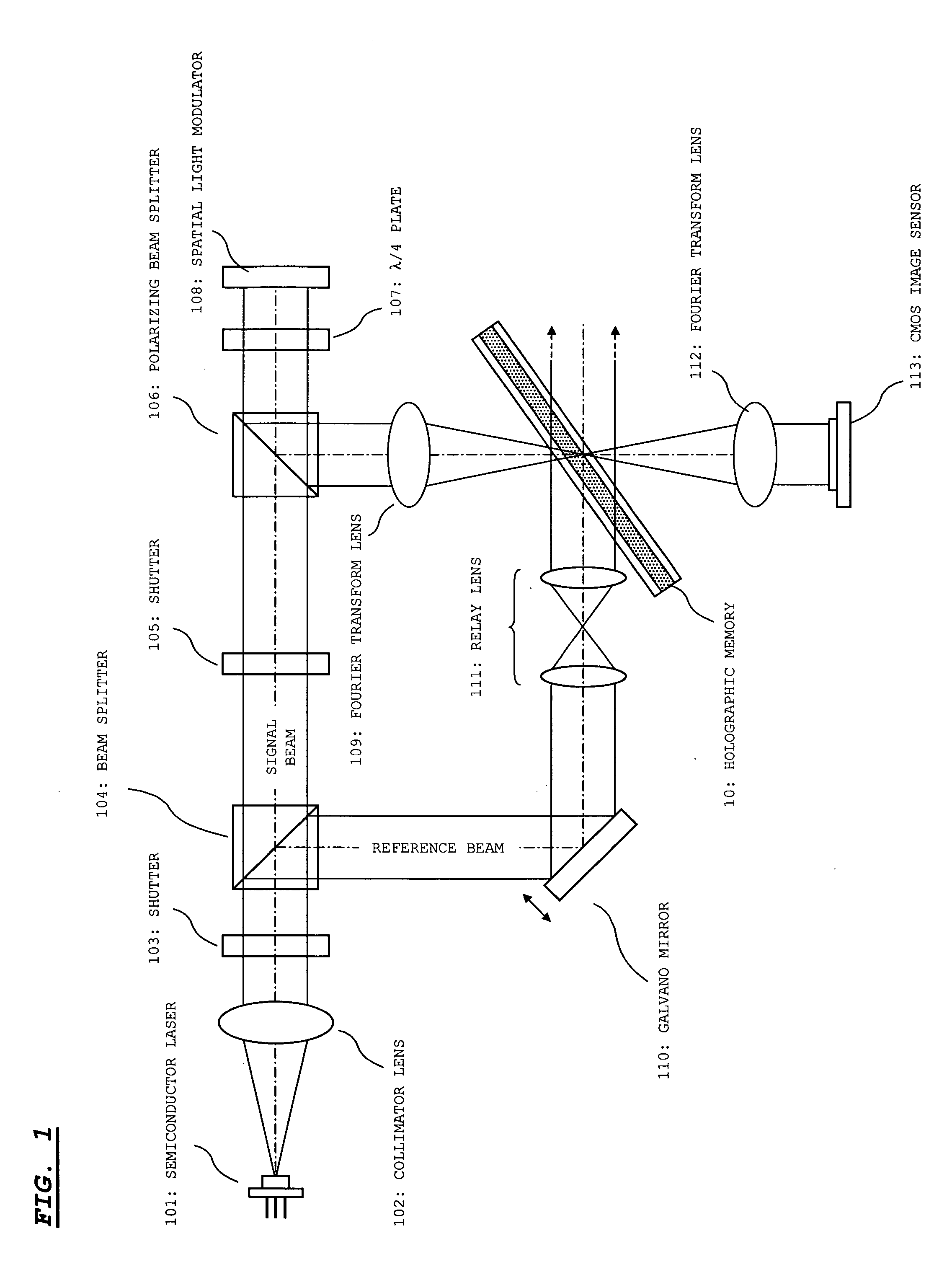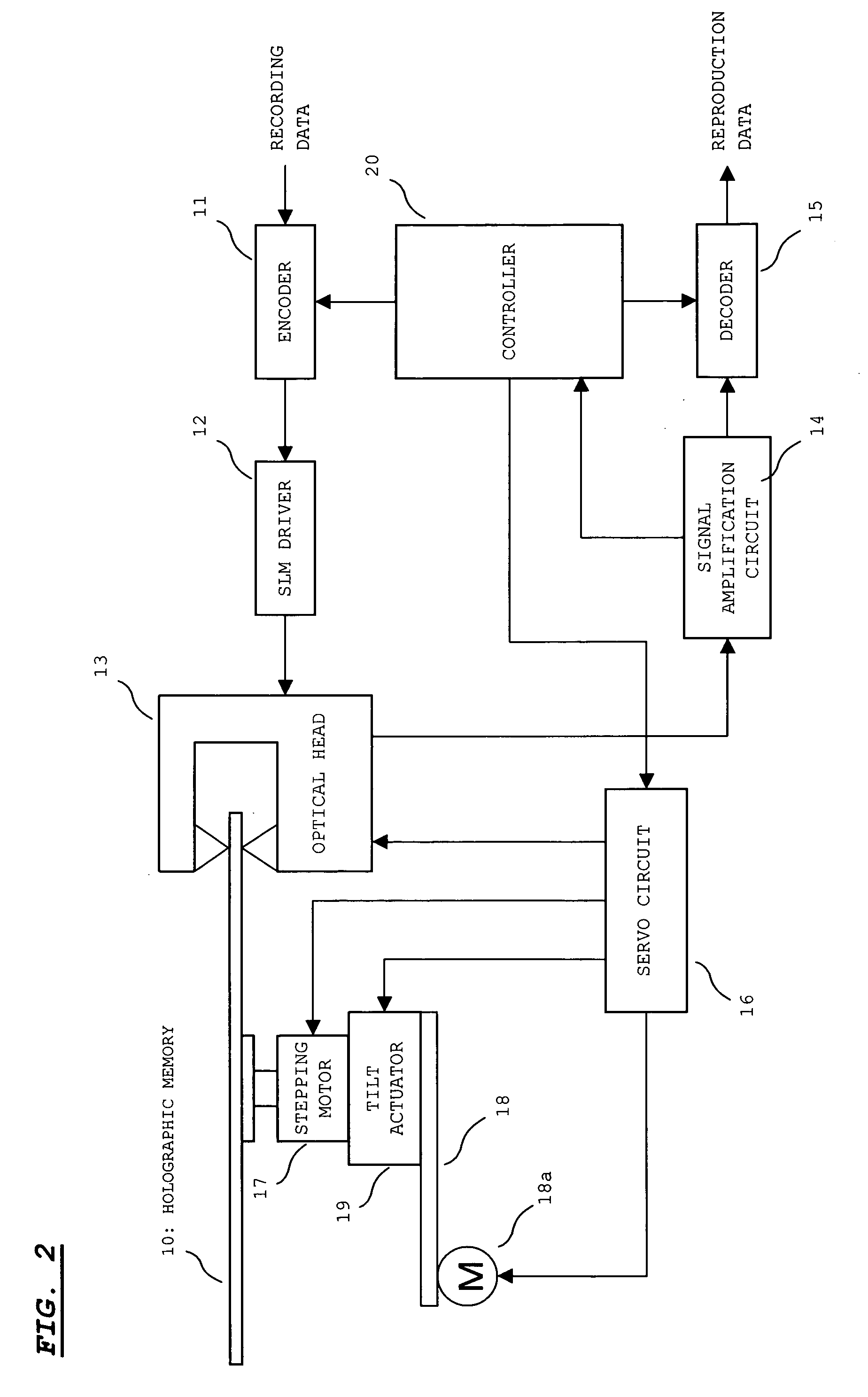Holographic memory medium, holographic memory device and holographic recording device
a technology of holographic memory and recording device, which is applied in the direction of recording/reproducing/erasing using optical interference patterns, data recording, instruments, etc., can solve the problems of inability to obtain an adequate reproduction signal, tilt error cannot be corrected by drive control of actuator for reference beam,
- Summary
- Abstract
- Description
- Claims
- Application Information
AI Technical Summary
Benefits of technology
Problems solved by technology
Method used
Image
Examples
embodiment 1
[0043]FIG. 1 shows an optical system of a holographic memory device according to this embodiment of the present invention. The shown optical system is used when information is recorded / reproduced in a transmissive holographic memory 10.
[0044] As shown in FIG. 1, this optical system includes a semiconductor laser 101, a collimator lens 102, a shutter 103, a beam splitter 104, a shutter 105, a polarizing beam splitter 106, a λ / 4 plate 107, a spatial light modulator 108, a Fourier transform lens 109, a galvano mirror 110, a relay lens 111, and a Fourier transform lens 112, and a CMOS (Complementary MOS) image sensor 113.
[0045] The semiconductor laser 101 emits a laser beam of a wavelength suited to the holographic memory 10. The collimator lens 102 converts the laser beam made incident from the semiconductor laser 101 into a parallel beam. The shutter 103 includes a mechanical shutter or the like, and passes / blocks a laser beam according to a control signal. Specifically, an OFF (pas...
embodiment 2
[0097] In Embodiment 1, the incident angle of the reference beam in the tangential tilt direction is maintained to the reference angle St to form the reference tilt hologram. Then, the total received light quantity is detected for each incident angle while the incident angle of the reference beam in the tangential tilt direction is changed relative to the reference tilt hologram. An incident angle associated with a largest total received light quantity is obtained as the reference angle St in the tangential tilt direction.
[0098] On the other hand, in this embodiment, a reference tilt hologram for obtaining the reference angle St (hereinafter referred to as a “Tn-reference tilt hologram”) is formed in the holographic memory in addition to the reference tilt hologram described in Embodiment 1 (hereinafter referred to as particularly a “Ra-reference tilt hologram” in this embodiment).
[0099] As in the case of the Ra-reference tilt hologram, it is preferable to form the Tn-reference ti...
embodiment 3
[0115] In Embodiment 2, each of the reference angles St and Sr is obtained by the method shown in FIG. 5. On the other hand, in Embodiment 3, each of the reference angles St and Sr is obtained with reference to the total received light quantities obtained while the reference beam is changed in the tangential tilt direction and the radial tilt direction.
[0116] In this embodiment, in forming the reference tilt hologram, the incident angle of the reference beam is maintained to a reference angle without being changed in the tangential tilt direction and in the radial tilt direction. The reference beam is allowed to enter at the reference angle to record only one kind of signal pattern (any pattern is allowed). Therefore, the reference tilt hologram is formed in the holographic memory 10.
[0117]FIG. 10 is a processing flow chart showing processing for obtaining and setting the reference angles St and Sr. This processing is performed before the recording and reproducing operations.
[011...
PUM
 Login to View More
Login to View More Abstract
Description
Claims
Application Information
 Login to View More
Login to View More - R&D
- Intellectual Property
- Life Sciences
- Materials
- Tech Scout
- Unparalleled Data Quality
- Higher Quality Content
- 60% Fewer Hallucinations
Browse by: Latest US Patents, China's latest patents, Technical Efficacy Thesaurus, Application Domain, Technology Topic, Popular Technical Reports.
© 2025 PatSnap. All rights reserved.Legal|Privacy policy|Modern Slavery Act Transparency Statement|Sitemap|About US| Contact US: help@patsnap.com



